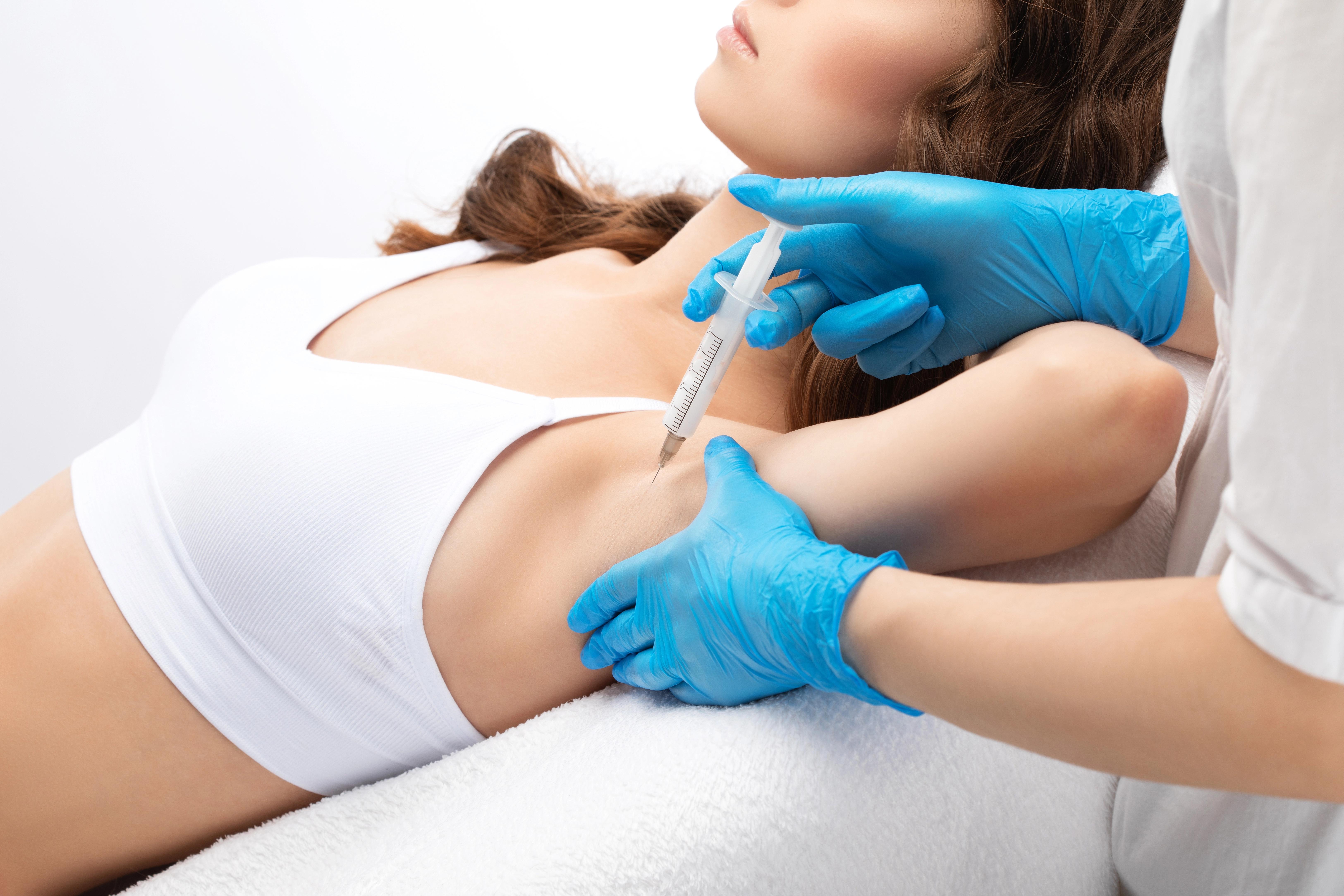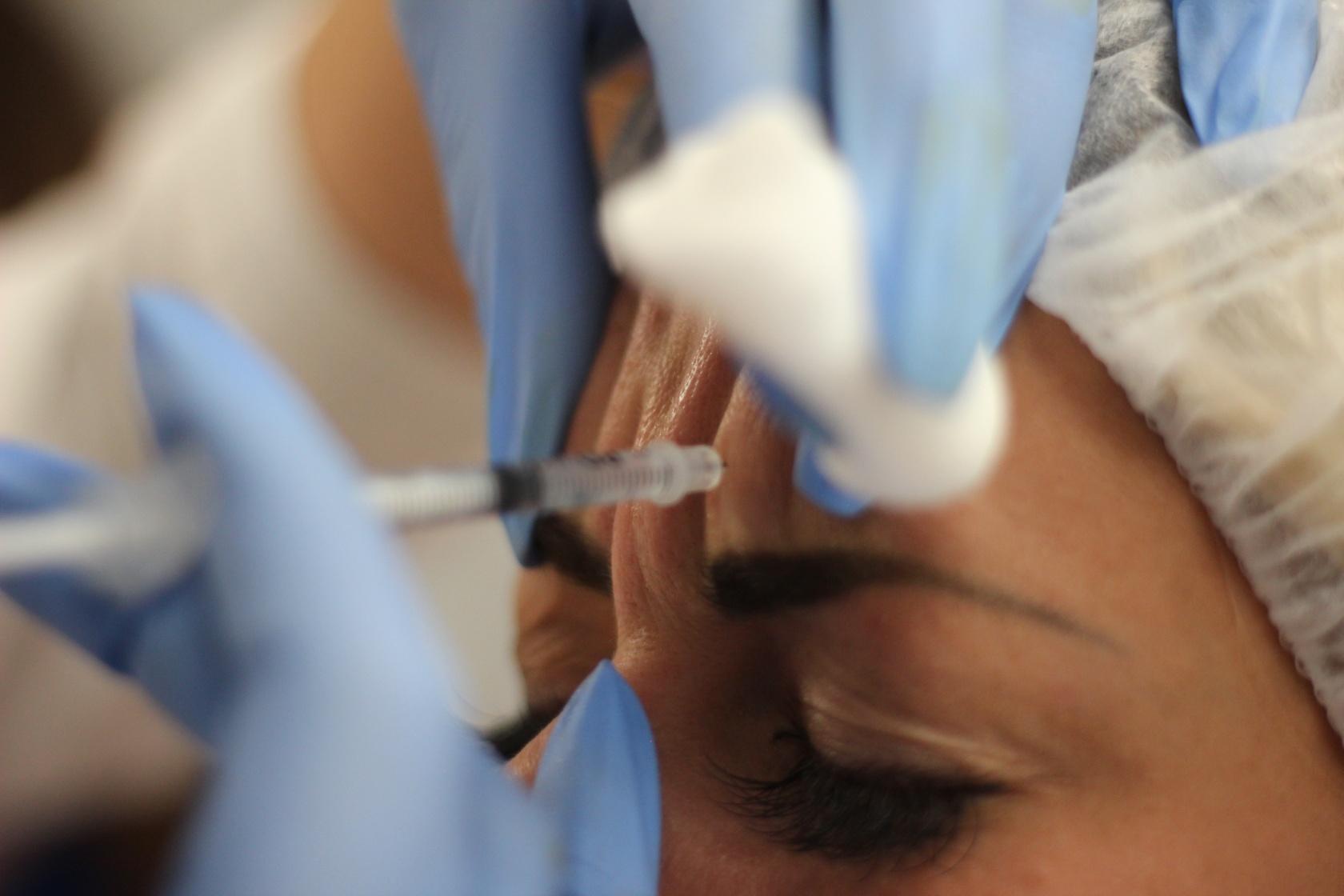
Say goodbye to sweaty palms and soaked clothes. Enjoy every workday and free moment feeling fresh and dry.
How does excessive sweating treatment work?
Are you struggling with excessive sweating? Modern medicine offers an elegant solution – the application of botulinum toxin, which can significantly reduce sweating for several months.
Botulinum toxin works by temporarily blocking the nerve endings responsible for activating the sweat glands. The procedure is quick, almost painless, and performed on an outpatient basis – most commonly in the underarm area, palms, or soles of the feet.
The effect begins within a few days and lasts approximately 6 to 9 months. After that, the treatment can be easily repeated.
This therapy is an ideal choice for those seeking an effective, safe, and discreet way to eliminate unwanted sweating and regain confidence in everyday situations.
Since every body reacts differently, it is advisable to consult a specialist first, who will recommend the most suitable approach for the treated area.
Price list – Botulinum toxin application
| Glabella | |
| Glabella + forehead | 6.870 Kč |
| Forehead | 3.850 Kč |
| Eyes | 3.250 Kč |
| Eyes + glabella + forehead | 10.100 Kč |
| Central parts of face - mouth vicinity | 2.000 Kč |
| Corners of the mouth | 2.000 Kč |
| Above upper lip | 2.000 Kč |
| Chin | 2.000 Kč |
| Armpit - sweat reduction |
Inquiry / Non-binding appointment request
More about sweating
Sweating is a natural process that plays a vital role in the human body. Its main function is thermoregulation. Through sweating, the body releases excess heat that constantly forms (even when we are resting or sleeping) — whether from muscle activity or metabolic processes. Sweating also helps eliminate harmful and toxic substances and acts as a natural protective filter against UV radiation.
The process of sweating is controlled by sweat glands located in the dermis. Their activity is regulated by the autonomic nervous system. On average, each person has between 3 and 4 million sweat glands. They are distributed throughout the body, except on the lips, nipples, and external genital organs. Anatomically, sweat glands are divided into small (eccrine) and large (apocrine) glands. They differ in size, number, body distribution, the composition of the sweat they produce, and how they respond to various stimuli.
Sweat itself is essentially odorless. It consists of about 99% water and dissolved solids — mainly sodium chloride, urea, uric acid, lactic acid (which has bactericidal effects), fatty acids, certain amino acids, and creatinine. Sweat has an acidic reaction. The unpleasant odor occurs only when bacteria on the skin and hair begin to break down proteins and fatty acids contained in sweat produced by the larger glands. The warm and moist environment of the armpits provides ideal conditions for bacterial growth.
The human body produces about 0.5–1 liter of sweat daily. The amount of sweat depends on external temperature and climate, the body’s heat production, physical exertion, and emotional stress.
A key factor affecting sweating is air humidity. When humidity is high, the air is almost saturated with water and cannot absorb more moisture from the body. That’s why humid heat feels more uncomfortable — the sweat doesn’t evaporate effectively and therefore doesn’t cool the body as efficiently as in dry heat.
Sweating is often a response to our emotional state. When preparing for something important or feeling nervous, nerve activity increases, stimulating the sweat glands, especially those on the palms and in the armpits.
Emotional sweating and sweating caused by heat or physical activity differ in how quickly the body begins to sweat. In the case of heat-induced sweating, it often takes a while before sweat appears, whereas emotional sweating can make the palms and armpits wet within seconds. Moreover, sweat produced during emotional stress tends to contain more compounds that bacteria break down, which is why it often has a stronger odor.
Sweating can also be a signal that something in our body is not functioning properly. Excessive sweating that is not caused by physical exertion or strong emotional stress is called hyperhidrosis or diaphoresis.
Excessive sweating occurs in about 3–4% of the population, and because it may indicate a serious underlying condition, it should not be underestimated. All forms of hyperhidrosis cause significant psychosocial discomfort and physical inconvenience to those affected.
There are two main forms of excessive sweating: generalized hyperhidrosis, which is less common, and localized hyperhidrosis, which more frequently affects the armpits (axillae), palms, and soles of the feet.
Another classification distinguishes between primary and secondary hyperhidrosis. Primary hyperhidrosis is a disorder of unknown origin, likely caused by a congenital predisposition. It may appear in childhood and persist throughout life, more often beginning in young adulthood. Emotional stimuli are usually the main triggers, which is why primary hyperhidrosis is sometimes referred to as emotional hyperhidrosis.
Secondary hyperhidrosis, on the other hand, is a symptom of another condition. It can accompany various disorders such as endocrine diseases (hormonal imbalances), typically menopause or hyperthyroidism, hypoglycemia (low blood sugar) in diabetes, or certain cancers such as pheochromocytoma, Hodgkin’s disease, carcinoid tumors, and other malignancies. It can also occur in neurological disorders (e.g., carpal tunnel syndrome) or spinal cord lesions, where the sweating may even be one-sided.
In cases of hyperhidrosis, when searching for the underlying cause, the physician should assess the patient’s weight and any fluctuations, blood pressure, heart rate, and any changes in these parameters. Body temperature and its daily variation, response to medications, and information about newly prescribed drugs are also important.
Attention should be paid to skin changes — rashes associated with systemic diseases, flushing (carcinoid), pronounced paleness (pheochromocytoma with excess adrenaline production), moist skin in thyrotoxicosis, or erythema nodosum. Examination of lymph nodes in all predilection areas is often overlooked but essential.
It is also necessary to rule out inflammatory diseases in the head and neck region, including dental issues, as well as to perform a lung auscultation and exclude inflammation in the gynecological or urological area.
The goal of hyperhidrosis treatment is to reduce sweat production to a level that is comfortable for the patient. Treatment options include conservative and surgical approaches.
